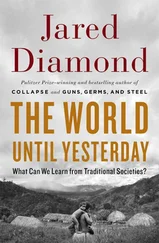Jared Diamond - Guns, Germs & Steel
Здесь есть возможность читать онлайн «Jared Diamond - Guns, Germs & Steel» весь текст электронной книги совершенно бесплатно (целиком полную версию без сокращений). В некоторых случаях можно слушать аудио, скачать через торрент в формате fb2 и присутствует краткое содержание. Жанр: 105. Описание произведения, (предисловие) а так же отзывы посетителей доступны на портале библиотеки ЛибКат.
- Название:Guns, Germs & Steel
- Автор:
- Жанр:
- Год:неизвестен
- ISBN:нет данных
- Рейтинг книги:5 / 5. Голосов: 1
-
Избранное:Добавить в избранное
- Отзывы:
-
Ваша оценка:
- 100
- 1
- 2
- 3
- 4
- 5
Guns, Germs & Steel: краткое содержание, описание и аннотация
Предлагаем к чтению аннотацию, описание, краткое содержание или предисловие (зависит от того, что написал сам автор книги «Guns, Germs & Steel»). Если вы не нашли необходимую информацию о книге — напишите в комментариях, мы постараемся отыскать её.
Guns, Germs & Steel — читать онлайн бесплатно полную книгу (весь текст) целиком
Ниже представлен текст книги, разбитый по страницам. Система сохранения места последней прочитанной страницы, позволяет с удобством читать онлайн бесплатно книгу «Guns, Germs & Steel», без необходимости каждый раз заново искать на чём Вы остановились. Поставьте закладку, и сможете в любой момент перейти на страницу, на которой закончили чтение.
Интервал:
Закладка:
SPEEDBOAT TOpolynesia • 349
Instead of the usual small village of low huts, surrounded by large gardens sufficient to feed the village, and with a few canoes drawn up on the beach, most of the area of Malai was occupied by two-story wooden houses side by side, leaving no ground available for gardens—the New Guinea equivalent of downtown Manhattan. On the beach were rows of big canoes. It turned out that Malai islanders, besides being fishermen, were also specialized potters, carvers, and traders, who lived by making beautifully decorated pots and wooden bowls, transporting them in their canoes to larger islands and exchanging their wares for pigs, dogs, vegetables, and other necessities. Even the timber for Malai canoes was obtained by trade from villagers on nearby Umboi Island, since Malai does not have trees big enough to be fashioned into canoes.
In the days before European shipping, trade between islands in the New Guinea region was monopolized by such specialized groups of canoe-building potters, skilled in sailing without navigational instruments, and living on offshore islets or occasionally in mainland coastal villages. By the time I reached Malai in 1972, those indigenous trade networks had collapsed or contracted, partly because of competition from European motor vessels and aluminum pots, partly because the Australian colonial government forbade long-distance canoe voyaging after some accidents in which traders were drowned. I would guess that the Lapita potters were the inter-island traders of the New Guinea region in the centuries after 1600 b.c.
The spread of Austronesian languages to the north coast of New Guinea itself, and over even the largest Bismarck and Solomon islands, must have occurred mostly after Lapita times, since Lapita sites themselves were concentrated on Bismarck islets. Not until around a.d. 1 did pottery derived from the Lapita style appear on the south side of New Guinea's southeast peninsula. When Europeans began exploring New Guinea in the late 19th century, all the remainder of New Guinea's south coast still supported populations only of Papuan-language speakers, even though Austronesian-speaking populations were established not only on the southeastern peninsula but also on the Aru and Kei Islands (lying 70-80 miles off western New Guinea's south coast). Austronesians thus had thousands of years in which to colonize New Guinea's interior and its southern coast from nearby bases, but they never did so. Even their colonization of North New Guinea's coastal fringe was more linguistic than genetic: all northern coastal peoples remained predominantly New Guineans in their genes. At
35o " GUNS, GERMS, AND STEEL
most, some of them merely adopted Austronesian languages, possibly in order to communicate with the long-distance traders who linked societies.
THUS, the outcome of the Austronesian expansion in the New Guinea region was opposite to that in Indonesia and the Philippines. In the latter region the indigenous population disappeared—presumably driven off, killed, infected, or assimilated by the invaders. In the former region the indigenous population mostly kept the invaders out. The invaders (the Austronesians) were the same in both cases, and the indigenous populations may also have been genetically similar to each other, if the original Indonesian population supplanted by Austronesians really was related to New Guineans, as I suggested earlier. Why the opposite outcomes?
The answer becomes obvious when one considers the differing cultural circumstances of Indonesia's and New Guinea's indigenous populations. Before Austronesians arrived, most of Indonesia was thinly occupied by hunter-gatherers lacking even polished stone tools. In contrast, food production had already been established for thousands of years in the New Guinea highlands, and probably in the New Guinea lowlands and in the Bismarcks and Solomons as well. The New Guinea highlands supported some of the densest populations of Stone Age people anywhere in the modern world.
Austronesians enjoyed few advantages in competing with those established New Guinean populations. Some of the crops on which Austronesians subsisted, such as taro, yams, and bananas, had probably already been independently domesticated in New Guinea before Austronesians arrived. The New Guineans readily integrated Austronesian chickens, dogs, and especially pigs into their food-producing economies. New Guineans already had polished stone tools. They were at least as resistant to tropical diseases as were Austronesians, because they carried the same five types of genetic protections against malaria as did Austronesians, and some or all of those genes evolved independently in New Guinea. New Guineans were already accomplished seafarers, although not as accomplished as the makers of Lapita pottery. Tens of thousands of years before the arrival of Austronesians, New Guineans had colonized the Bismarck and Solomon Archipelagoes, and a trade in obsidian (a volcanic stone suitable for making sharp tools) was thriving in the Bismarcks at least 18,000
SPEEDBOAT TOpolynesia • 351
ears before the Austronesians arrived. New Guineans even seem to have xpanded recently westward against the Austronesian tide, into eastern Indonesia, where languages spoken on the islands of North Halmahera and of Timor are typical Papuan languages related to some languages of western New Guinea.
In short, the variable outcomes of the Austronesian expansion strikingly llustrate the role of food production in human population movements. Austronesian food-producers migrated into two regions (New Guinea and Indonesia) occupied by resident peoples who were probably related to each other. The residents of Indonesia were still hunter-gatherers, while the residents of New Guinea were already food producers and had developed many of the concomitants of food production (dense populations, disease resistance, more advanced technology, and so on). As a result, while the Austronesian expansion swept away the original Indonesians, it failed to make much headway in the New Guinea region, just as it also failed to make headway against Austroasiatic and Tai-Kadai food producers in tropical Southeast Asia.
We have now traced the Austronesian expansion through Indonesia and up to the shores of New Guinea and tropical Southeast Asia. In Chapter 19 we shall trace it across the Indian Ocean to Madagascar, while in Chapter 15 we saw that ecological difficulties kept Austronesians from establishing themselves in northern and western Australia. The expansion's remaining thrust began when the Lapita potters sailed far eastward into the Pacific beyond the Solomons, into an island realm that no other humans had reached previously. Around 1200 b.c. Lapita potsherds, the familiar triumvirate of pigs and chickens and dogs, and the usual other archaeological hallmarks of Austronesians appeared on the Pacific archipelagoes of Fiji, Samoa, and Tonga, over a thousand miles east of the Solomons. Early in the Christian era, most of those same hallmarks (with the notable exception of pottery) appeared on the islands of eastern Polynesia, including the Societies and Marquesas. Further long overwater canoe voyages brought settlers north to Hawaii, east to Pitcairn and Easter Islands, and southwest to New Zealand. The native inhabitants of most of those islands today are the Polynesians, who thus are the direct descendants of the Lapita potters. They speak Austronesian languages closely related to those of the New Guinea region, and their main crops are the Austronesian Package that included taro, yams, bananas, coconuts, and breadfruit.
With the occupation of the Chatham Islands off New Zealand around
3 5 2 ' GUNS, GERMS, ANDsteel
a.d. 1400, barely a century before European "explorers" entered the Pacific, the task of exploring the Pacific was finally completed by Asians. Their tradition of exploration, lasting tens of thousands of years, had begun when Wiwor's ancestors spread through Indonesia to New Guinea and Australia. It ended only when it had run out of targets and almost every habitable Pacific island had been occupied.
Toanyone interested in world history, human societies of East Asia and the Pacific are instructive, because they provide so many examples of how environment molds history. Depending on their geographic homeland, East Asian and Pacific peoples differed in their access to domesticable wild plant and animal species and in their connectedness to other peoples. Again and again, people with access to the prerequisites for food production, and with a location favoring diffusion of technology from elsewhere, replaced peoples lacking these advantages. Again and again, when a single wave of colonists spread out over diverse environments, their descendants developed in separate ways, depending on those environmental differences.
For instance, we have seen that South Chinese developed indigenous food production and technology, received writing and still more technology and political structures from North China, and went on to colonize tropical Southeast Asia and Taiwan, largely replacing the former inhabitants of those areas. Within Southeast Asia, among the descendants or relatives of those food-producing South Chinese colonists, the Yumbri in the mountain rain forests of northeastern Thailand and Laos reverted to living as hunter-gatherers, while the Yumbri's close relatives the Vietnamese (speaking a language in the same sub-subfamily of Austroasiatic as the Yumbri language) remained food producers in the rich Red Delta and established a vast metal-based empire. Similarly, among Austronesian emigrant farmers from Taiwan and Indonesia, the Punan in the rain forests of Borneo were forced to turn back to the hunter-gatherer lifestyle, while their relatives living on Java's rich volcanic soils remained food producers, founded a kingdom under the influence of India, adopted writing, and built the great Buddhist monument at Borobudur. The Austronesians who went on to colonize Polynesia became isolated from East Asian metallurgy and writing and hence remained without writing or metal. As we saw m Chapter 2, though, Polynesian political and social organization and econo-
Интервал:
Закладка:
Похожие книги на «Guns, Germs & Steel»
Представляем Вашему вниманию похожие книги на «Guns, Germs & Steel» списком для выбора. Мы отобрали схожую по названию и смыслу литературу в надежде предоставить читателям больше вариантов отыскать новые, интересные, ещё непрочитанные произведения.
Обсуждение, отзывы о книге «Guns, Germs & Steel» и просто собственные мнения читателей. Оставьте ваши комментарии, напишите, что Вы думаете о произведении, его смысле или главных героях. Укажите что конкретно понравилось, а что нет, и почему Вы так считаете.










